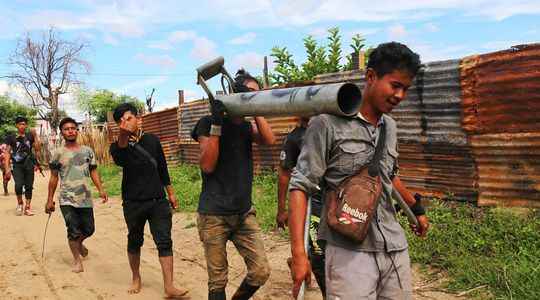Aye Sher has the unfathomable gaze of those who have seen their world crumble without warning. For this resident of the state of Kayah, in the south-east of Burma, the earthquake occurred on December 21, 2021, when the soldiers burst into her village. “There was fighting nearby, they burned six houses including ours, we fled into the forest to hide.” When she tries to return home, residents dissuade her. “The army had landmines all around.”
Before this tragedy, this Karenni peasant lived comfortably off the produce of the land – rice, vegetables, fruit… “We had a pretty wooden house, with a zinc roof.” Today, she shares a narrow bamboo hut with her husband and four children, leaning against the intimidating wall of the jungle, in the Daw Noe Khu camp, established a few kilometers from the Thai border, where nearly of 2,500 displaced Burmese.
Rescued after a week of perilous walking in the mountains, Aye Sher could have known a more disastrous fate – like that of these 35 civilians massacred on suspicion of “terrorism” a few kilometers from her village by Burmese soldiers the day before Christmas (a holiday celebrated in this predominantly Christian region).
According to the United Nations, the abuses of the Burmese army (sit tat) have, since the February 2021 coup, caused the displacement of 750,000 people across the country, including 74,000 of the Karenni ethnic group. Daw Noe Khu is one of the many reception camps for these refugees. “In one year, we have built 400 houses, a school, a dispensary, an administrative center and two churches, Baptist and Catholic,” said Carter, the camp leader, a 43-year-old Karenni addicted to betel quid. he prepares by conversing. A titanic task: it was necessary to cut, uproot and clear several hectares of dense and steep jungle. “People have nothing to do, some are depressed,” laments Carter. Anxiety fueled by the regular overflights of Burmese fighters and helicopters.
250 armed groups
Surprisingly, Kayah State, one of the smallest administrative subdivisions of Burma and the least populated region (286,000 inhabitants), is one of the most virulent centers of opposition in the country. In May 2021, three months after the military junta putsch, a handful of young Karennis created the KNDF (Karenni Nationalities Defense Force), an armed civilian movement that claims 8,000 to 10,000 fighters. “Political awareness is highly developed among young people, who have always felt oppressed by the Burmese governments, military or civilian,” explains Joseph, 34, a member of the central committee. Over the months, this group has asserted itself as a formidable force, organizing ambushes, attacks and sabotage against the Burmese security forces. In retaliation, the army embarked on a ruthless cycle of repression: 320 civilians were killed in Kayah State, hundreds more injured.
For decades, the Karennis and other ethnic minorities (Chins, Kachins, Karen) have been fighting to obtain a form of self-determination “within the framework of a federal state which would notably guarantee better control over the exploitation of natural resources”. , adds Joseph.
It is estimated that 250 armed groups, present in the townships (cantons), are fighting against the dictatorship, with numbers fluctuating between 40,000 and 100,000 men for the armed wing of the Government of National Unity, (ousted by the military junta but recognized by the European Parliament) and 30,000 to 35,000 soldiers for the ethnic guerrillas.
The outcome of this “revolution”, which has already killed more than 2,300 civilians according to a local NGO, remains more than ever unpredictable. “The belligerents are fighting on several fronts, summarizes Andrew Selth, specialist in the conflicts in Burma, in a publication of the Australian study center Lowy Institute. None seems to have the capacity to strike a decisive blow. unforeseen event tilts the balance in favor of one side or the other, the civil war in Burma seems doomed to last. And the refugees from Daw Noe Khu are not about to return to their villages.
